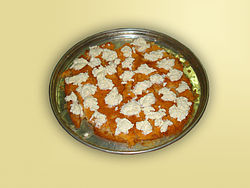Knafeh: Difference between revisions
No edit summary |
m +image |
||
| Line 27: | Line 27: | ||
==Ekmek Kadayıfı== |
==Ekmek Kadayıfı== |
||
[[Image:Kaymaklı Ekmek Kadayıfı.jpg|''Ekmek Kadayıfı'' (i.e. bread kataif); a traditional Turkish dessert.|thumb|250px]] |
|||
''Ekmek kataif'' 'bread kataif' is a traditional Turkish dessert, similar to a [[bread pudding]] and not containing kataif pastry. It is served with [[kaymak]], a kind of clotted cream. |
''Ekmek kataif'' 'bread kataif' is a traditional Turkish dessert, similar to a [[bread pudding]] and not containing kataif pastry. It is served with [[kaymak]], a kind of clotted cream. |
||
Revision as of 19:33, 30 August 2007
Kadaif, kadayıf (Turkish), kataifi, kadaifi (Greek κα(ν)ταΐφι), is a very fine vermicelli-like pastry used to make sweet pastries and desserts. It is sometimes known as shredded phyllo.
It is found from the Balkans to the Levant, and is a feature of Turkish, Greek, and Levantine cuisine.

Kadaif is made by drizzling a row of thin streams of flour-and-water batter onto a turning hot plate, so they dry into long threads resembling Shredded Wheat. The threads are then collected into skeins.[1]
The threads are used to make pastries of various forms (tubes or nests), often with a filling of chopped nuts, like that used for baklava. A kadaif dessert is made by layering a mat of kadaif pastry, a filling of chopped nuts, then another mat of pastry. The pastries or dessert are painted with melted butter, baked until golden brown, then drenched in sugar or honey syrup.
Kataifi is sometimes used, in fusion cuisine, to make savory pastries.[2]
Kunāfah/Künefe

Another variant has a cheese filling and called knāfeh, kunāfah, or kunfeh (Arabic; كنافة, (Turkish;Künefe).
Knafeh was invented in the Palestinian city of Nablus (called Knafeh Nabulsiyye). It is the most famous throughout the Arab world.
Knafeh dough comes in three types:
- khishneh (Arabic خشنة) "rough", consisting of kadaif pastry, which looks like long thin noodle threads.
- na'ama (Arabic ناعمة) "fine", consisting of small pieces of semolina clustered together.
- mhayara (ِِArabic محيرة): which is a mixture of both khishneh and naa'ama.
The pastry is heated with some butter, margarine or palm oil for a while and then spread with soft cheese (see Nabulsi cheese) and more pastry; or the khishneh kunafah is rolled around the cheese. A thick syrup, consisting of sugar, water and a couple of drops of lemon juice, is poured on the pastry during the final minutes of cooking.
In Turkey, only kadayif pastry (shredded pastry;called "wire kadayif") is used for making künefe. Kadayif is not rolled around the cheese. Cheese is put in between two layers of wire kadayif. It is cooked in small copper plates, served very hot in syrup with clotted cream "kaymak" and pistachio/walnut.
Often the top layer of kadaif pastry is colored using orange food coloring. Crushed pistachios are typically sprinkled on top as a garnish.
Ekmek Kadayıfı

Ekmek kataif 'bread kataif' is a traditional Turkish dessert, similar to a bread pudding and not containing kataif pastry. It is served with kaymak, a kind of clotted cream.
Etymology
From the Ottoman Turkish word قطائف [kadaif], plural of Arabic قطيفه [qatˁiːfah] 'velvet'. This word originally referred to a kind of crêpe which was later cut into strips resembling modern kadaif.
